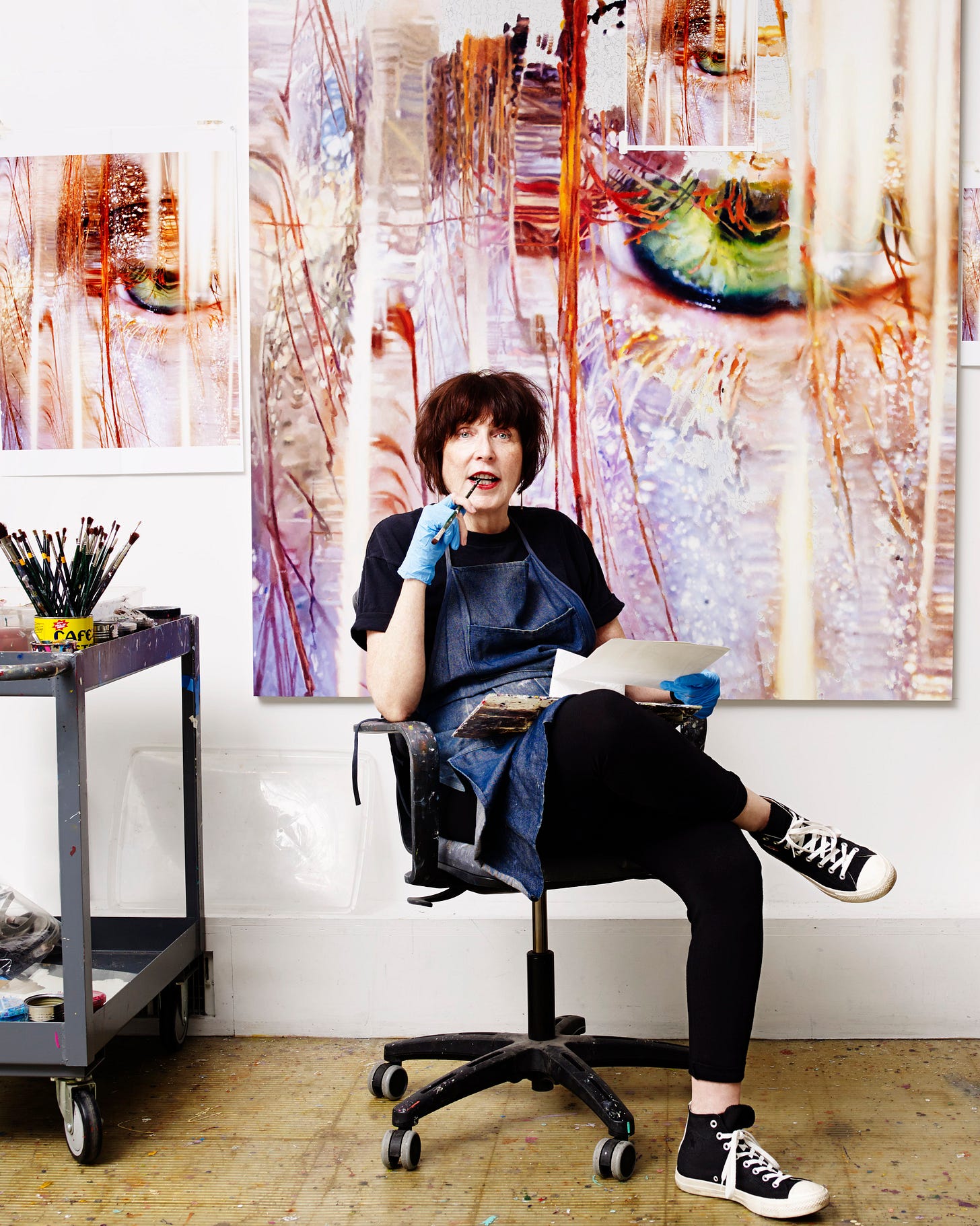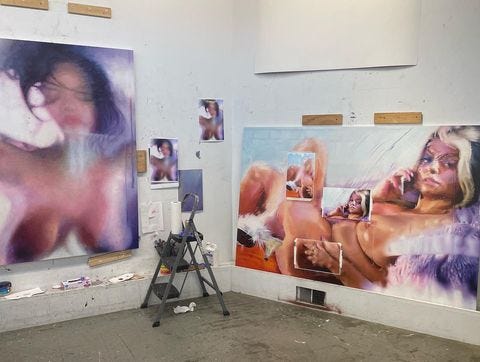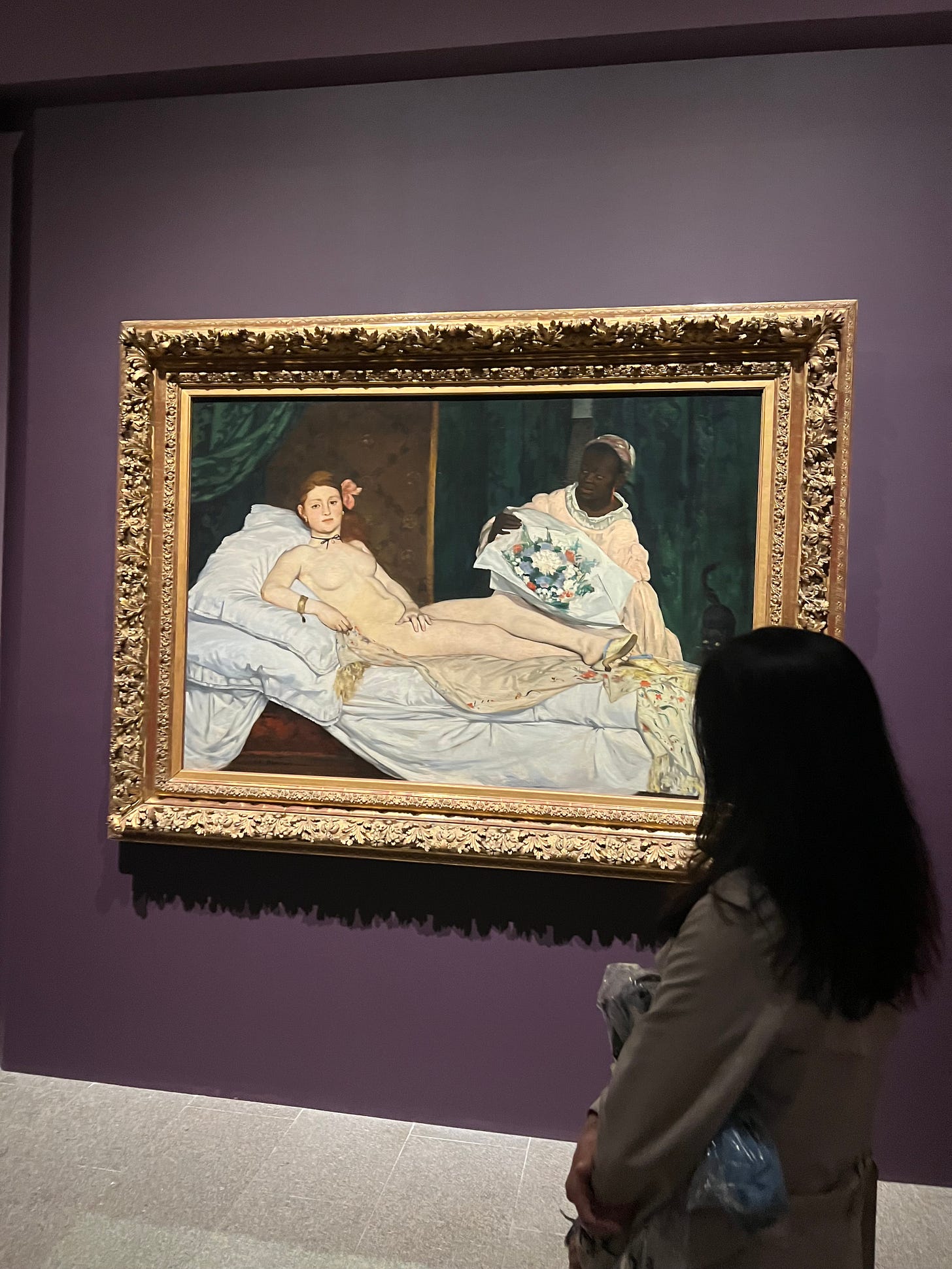Herb Sundays 98: Marilyn Minter
The legendary visual artist shares her long-running studio playlist.
Herb Sundays 98: Marilyn Minter (Apple, Spotify, Tidal, Amazon).
Art by Michael Cina. Thank you Salon 94.
"I'm so old and I've been listening to music my whole life. I started my playlist years ago and whenever I hear a song that I like I just add it. I think it's over 6 hours now. It's kind of perfect for a photoshoot. I usually listen when shooting. And sometimes when I'm editing, that way I won't get sick of it. I do not listen to it unless I'm working." - Marilyn Minter
The work of being an artist is daunting in that you not only have to find your voice and style but to be willing to be seen as wrong, even if you are right. Most great artists lead the culture by a decade or more and some are too far ahead their entire lives. Marilyn Minter, an artist who has found her public, “deftly explores American culture’s pathology of glamour through painting, photography, and video works which focus primarily on the female body and its treatment in popular media.” She’s been ahead of her time for most of her career, early around norms of body positivity and aging in fashion, sex work and power, and the push/pull of celebrity, marketing, and pornography. As she told the New York Times this year: “If you’re lucky as an artist, you’re still alive when you’re starting to communicate… And I feel like, OK, people are starting to see me now.”

In the past decade-plus, Minter has found a new generation of admirers in young people, but where her work slightly veers from the contemporary moment is that it sits on the fault line of pleasure and morality without tipping its hat to a stable opinion. Minter is not a scold or firmly literal, which has gotten her in trouble and even “banished” from the art world at one point for a lack of legibility around indulguing in or critiquing the culture we live in. It’s this hedonic risk that has added her firmly to the pantheon of American greats. Apart from the inimitable style of her work, the fundamental friction lies off the canvas. Minter asks who gets to own the pleasure of art, both in the making of it and the enjoyment of it. Her lineage perhaps belongs to multiple schools and genres. She’s a Diane Arbus student of the realistic photographic subject, a Warhol acolyte (and Koons competitor) who works with the language of implied sex and advertising, and a photorealist above all. I see her playing with meaning amongst Pictures Generation artists like Cindy Sherman and Richard Prince, punching up existing mass culture language. She also calls her work impressionist which increasingly feels perfect.
Blue Poles (2007) is one of my favorite contemporary paintings by any artist. It’s the constellation of the natural and the unnatural, and borne of narrative and none at all.
From an interview with Flamingo:
She spreads images out on the table. Among them is the photograph she used for Blue Poles, a close-up of the freckled bridge of a woman’s nose, caked on either side with glittery teal eye shadow, finished with a whitehead above the left eyebrow. “You’ve seen freckles now in the culture, but they were nowhere when I was growing up,” she says.
The photorealism (when you realize this is indeed enamel) is the shocker, but upon review, the “painterly” and impressionistic bits become clear. The way the eyebrows jut into the surface unnaturally and then when the cloudy globes in the inner eyes emerge. The whitehead is the fireworks display. What shouldn’t be appealing is now inescapable, and the natural is made more beautiful by its strangeness.
The language of her work works both ways. Are you, as a viewer, complicit by enjoying this work? As a woman, is Minter absolved of making this kind of imagery, or is she implicated as a co-conspirator? Even the making of her work, often starting as a photoshoot (Minter is known to personally cut her models’ hair or bangs, a trust fall from the celebs she sometimes shoots) and with this playlist in fact, behind a sheet of steamed glass, then photoshopped to pieces, reassembled, painstakingly painted by her and her team. The truth is somewhere between all these layers but we’ll never quite know and Minter definitely won’t be the one to tell us.
[Autre Magaine] KUPPER: Can you talk about where your fascination with all these elements comes from - pearls, moisture, slime, condensation?
MINTER: Everything I do exists. I just push a little further. It’s my way of creating a 21st century version of everything that’s already been there. That’s the only way I know how to do it. With this piece of glass in front of it. It exists somewhere. I’m always interested in something that I know, and how do I make an image of it? It exists but I’ve never seen it. I’ve never seen that image so I try to make that image that we all know exists but hasn't been made yet?
It’s her sense of play and irreverence, as well as her political activism that has found her fitting in more in the current culture than ever. She’s a champion of other artists (her Instagram shares this enjoyment of other’s art), and of youth. Minter is the cool aunt to so many, whether they know her or not, a beacon for doing the right thing.
Current and forthcoming shows:
Marilyn Minter, Lehmann Maupin, Seoul, South Korea, 2024
In Focus. A Closer Look at Photorealism, Centraal Museum, Utrecht, Netherlands, 2024
Friends & Lovers, FLAG Art Foundation, New York, USA, 2023
Returning the Gaze
As the canon has been expanded and remade to include non-male artists who have been overlooked by critics and institutions, we can capture more of a complete picture of art history and draw parallels that may have eluded us. When working on this I started thinking of Édouard Manet, the 19th-century French titan who many see as a/the forefather of modern art. It feels strange to focus on a male painter after a post about Minter, but I love the parallel of two artists who found inspiration in the culture around them and in doing so, have been more truthful than their peers.
Minter posits that we have “hundreds of years of softcore porn” thanks to the female body depicted by male painters so her work is perhaps a suggestion of taking it back. Manet may have been an early ancestor of Minter’s in its challenge of this subject. Also, Manet and Minter both play with the game of painting as a psychological feat, creating complexities around fact and fiction, as such both artists worked ahead of their time.
Currently on view at The Met is Manet/Degas which is positioned as a “friends and rivals” type show that depicts a high-stakes game in the making of modernity. The ending is sort of a tearjerker too, where Degas who outlived his friend, becomes a custodian of Manet’s work as a collector and advocate. My art history professor at Michigan, Howard Lay, made a huge impression on me by introducing me to Manet and his contemporaries, and their work as cultural subversives which helped move my understanding of art and music forward as such.
The centerpiece of the show is Manet’s Olympia (1863) which is finally seen on American shores with this exhibit. The Washington Post critic Sebastian Smee calls it the “Mona Lisa of modern art” The New York Times says:
Its image of a Paris courtesan, with tungsten-white skin and a level gaze, stretched out on her bed and approached by a Black female attendant bearing flowers, punched many a hot button — social, aesthetic and ethical — in French bourgeois culture. (A catalog essay by the Met curator-at-large Denise Murrell is a must-read on this.) And, surrounded by some of Manet’s other in-your-face radical pictures from the same time, it turns the gallery into a kind of atomic reactor, blasting complex energy out in all directions.
Smees’ piece reminds us that Olympia is also indeed, a fiction:
You could look at “Olympia” and concoct a cute little story about a glamorous courtesan if you wanted. But Manet made sure you would also see Victorine Meurent, his regular model, and Laure, a Black woman (family name unknown) who lived a short walk from his home in Paris’s Batignolles district.
Olympia was a shocker in its day due to the subject matter and the grand scale of such a work. The courtesan who receives flowers from a client perhaps, confronts the viewer, implicating them in the business. We as viewers are uncomfortable to see a black woman in this role but the Met is keen to comfort us that her presence relates to the burgeoning free Black community in Paris at this time. Olympia is a stage set, and Victorine and Laure, working in cahoots with Manet, are integral in its creation.
Olympia is an allegory of a classic style of painting and a fabrication of sorts. Minter’s photoshopped images (that she made) turned to paint have helped her work resist the idea of “real” but like fashion and marketing, they become more believable as a result. Minter and Manet play with the conscience and desires of the viewer or as Smee says: “It is a gaze that turns the whole game back on us.”
From the field.
My Friend Katy Hessel’s The Great Women Artists Substack and podcast are unmissable and her 2023 book The Story of Art Without Men is crucial for your gift/wishlist. Here’s her podcast with Minter which gives you a better sense of her work than I can.
Further into canon-remaking, the newly founded Gemma collective is functioning as an “onchain art ecosystem built by and for artists” and has already offered work by faves such as Sougwen Chung and Petra Cortright. Check them out via their Substack too:









